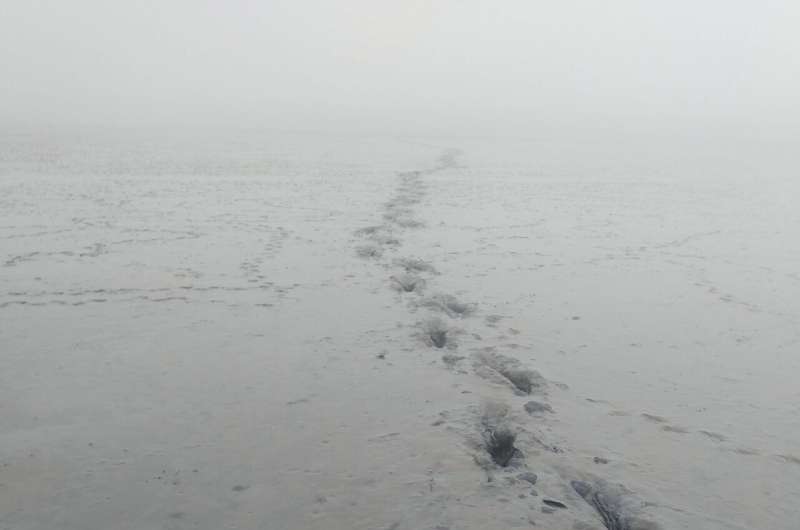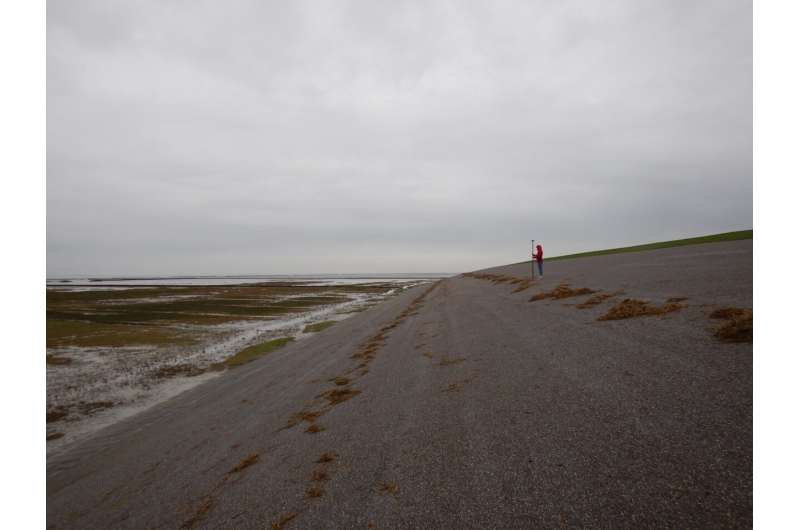This article has been reviewed according to Science X's editorial process and policies. Editors have highlighted the following attributes while ensuring the content's credibility:
fact-checked
peer-reviewed publication
trusted source
proofread
Salt marshes protect the coast, but not where it is needed most

Salt marshes provide multiple ecosystem services, and one of those is protection of the coast against flooding. This is especially important in low-lying countries like the Netherlands.
Scientists from the University of Groningen and the Royal Netherlands Institute for Sea Research (NIOZ), in collaboration with the local water authority, have monitored wave run-up during storms over a three-year period. The results, which were published in the Journal of Applied Ecology, help the water authority to quantify the protective effect of salt marshes.
For three years, ecologist Beatriz Marin-Diaz always had one eye on the weather forecast during the storm season. "After a storm we had to visit our research area to assess the impact of the waves," she explains.
The research area was situated along the Wadden Sea, a shallow zone between a range of barrier islands and the northern coast of the Netherlands consisting of tidal flats and wetlands. "Most of our knowledge about the protection these marshes provide is from models. However, little data is available on what is really happening in the open air."
Observations
Along the coastline, Marin-Diaz has taken different measurements, such as elevation of the mud flats, the width of salt marshes, and the vegetation growing there. The impact of storms was assessed using wave loggers, but also by measuring the position of flood marks on the dikes. Next to the measurements she took herself, Marin-Diaz also received data on wind direction and strength from the Royal Dutch Meteorological Institute (KNMI).
Moreover, she analyzed charts dating back some twenty years to study changes in the size of salt marshes. The paper in the Journal of Applied Ecology is based on the observations and measurements during three storm seasons.
The results show that salt marshes indeed reduce the wave run-up on dikes. "The key message is that compared to bare tidal flats, marshes were more effective in reducing run-up on the dikes," explains Marin-Diaz.
"This finding is not dependent on the wind direction of the storm, the exposure relative to the barrier islands, the grazing state of the marsh, or the vegetation type." The main drivers appeared to be the foreshore elevation and marsh width: higher foreshores and wider marshes provide more protection.

Moderating influence
Furthermore, Marin-Diaz observed that in areas where the mud flat elevation is relatively low, salt marshes are absent. Her long-term analysis showed that marshes expanded in areas where the adjacent tidal flats where higher (more than 0.5m above the average local sea level), while salt marshes retreated mainly where the mudflats in front of them were affected by erosion. "The areas where marshes are not developing are in turn the ones that would need more protection. Our conclusion is therefore that in some locations, we will still depend on hard engineering solutions because these nature-based defenses are not effective enough." This is an important conclusion for the local water authority.
"The study provides data that allow us to estimate the reduction of wave height and run-up depending on the presence and characteristics of the salt marshes in front," comment Kornelis de Jong and Jan-Willem Nieuwenhuis, two co-authors from the water authority. "We can now distinguish between protective requirements of dike stretches with and without salt marshes. This will have a moderating influence on future reinforcement works and their costs along these stretches."

Wading birds
In areas where marshes do not naturally occur, human interventions can help with their establishment. Marin-Diaz says, "Building sedimentation fields or adding sediment to stimulate the growth of new salt marshes could be one solution, although creating new marshes may have drawbacks as well. It would be at the expense of tidal flats, which are important to wading birds. Furthermore, in some locations, marshes are simply not able to grow, even with human interventions. In that case, strengthening the dikes may be required."
More information: Using salt marshes for coastal protection: effective but hard to get where needed most, Journal of Applied Ecology (2023). DOI: 10.1111/1365-2664.14413
Journal information: Journal of Applied Ecology
Provided by University of Groningen




















